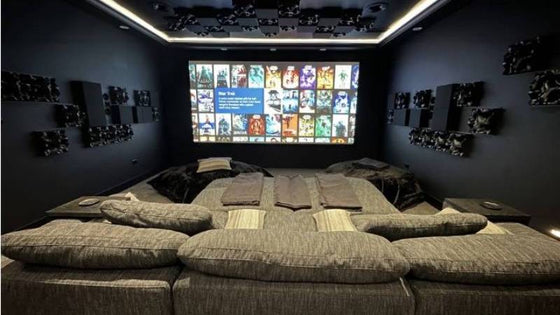Creating a system you love shouldn't be difficult. The Acoustic Frontiers blog is here to help.

This article reviews HTDV and film content aspect ratios and looks at ways to match content to display. These include manual and automated screen masking systems as well as anamorphic lenses and the ‘zoom’ method.
Aspect ratio describes the relationship between the width and the height of an image. 70-80% of modern movies are filmed in an aspect ratio of 2.35:1 or 2.4:1, meaning the image is over 2x wider than it is high. HDTV, however, uses a 1.78:1 aspect ratio. There are further variations on aspect ratio including the 1.88:1 used in US movies and the 1.66:1 European standard. The
classic movies of the pre-1950s era were often filmed in 1.33:1.

What’s clear is that there is no standard aspect ratio. We like to design our systems so they match the content that our clients typically watch. Usually this means a 2.35:1 aspect ratio screen but on occasion we might suggest something alternative.
The wrinkle with using a 2.35:1 screen is that virtually all (99.99%) projectors have 1.78:1 aspect ratio imaging chips. This means that some of the light output capabilities of the projector
are lost when displaying 2.35:1 content as those parts of the imaging chip are unused. Furthermore all content with an aspect ratio under 2.35:1 will be projected above and below the screen and will therefore not be visible.
Solutions to these issues typically involve using an electronic scaling to first vertically stretch the 2.35:1 image to fill the whole imaging chip and then using an external anamorphic lens to horizontally stretch the image to give it back it’s original aspect ratio. The anamorphic lens is typically mounted to a sled such that it can be moved in and out of the light path. This type of projection technique is known as constant image height (CIH).

In the last few years another technique has appeared which is to use memories in the projector for zoom and focus. With 2.35:1 films the projector can be zoomed in to fill the screen and with 1.78:1 content the projector can be zoomed out.
A related challenge is how to manage areas of the screen where images are not actively being displayed. With a 2.35:1 screen and an anamorphic lens the side portions of the screen will be unused with content under 2.35:1. If one uses a 1.78:1 aspect ratio screen (more commonly called a 16:9 screen) then with modern 2.35:1 movie content the top and bottom of the screen will be
unused.
Even when a projector is not actively projecting an image on some part of its chip there will still be some light output which will be visible on the projection screen. With low contrast ratio projectors these bars are often greyish rather than the near black seen with very high contrast projectors. These bars subjectively reduce the dynamic range that the viewer sees. For this reason masking systems are the optimal way to match screen with content.
Masking systems typically comprise black material which is manually placed or electronically pulled over the screen. Properly set up the content perfectly matches the unmasked screen size and perceived dynamic range is maximized.



Need help designing a projection system or choosing a screen, projector, masking system or anamorphic lens? Contact us now!
"No other subwoofer system I’ve owned even comes close to what this room delivers. Reaching out to Acoustic Frontiers was one of the best decisions I’ve made—I highly recommend working with them if you want to get the most out of your theater."

Nyal Mellor, Founder, Acoustic Frontiers


Nyal Mellor
Author